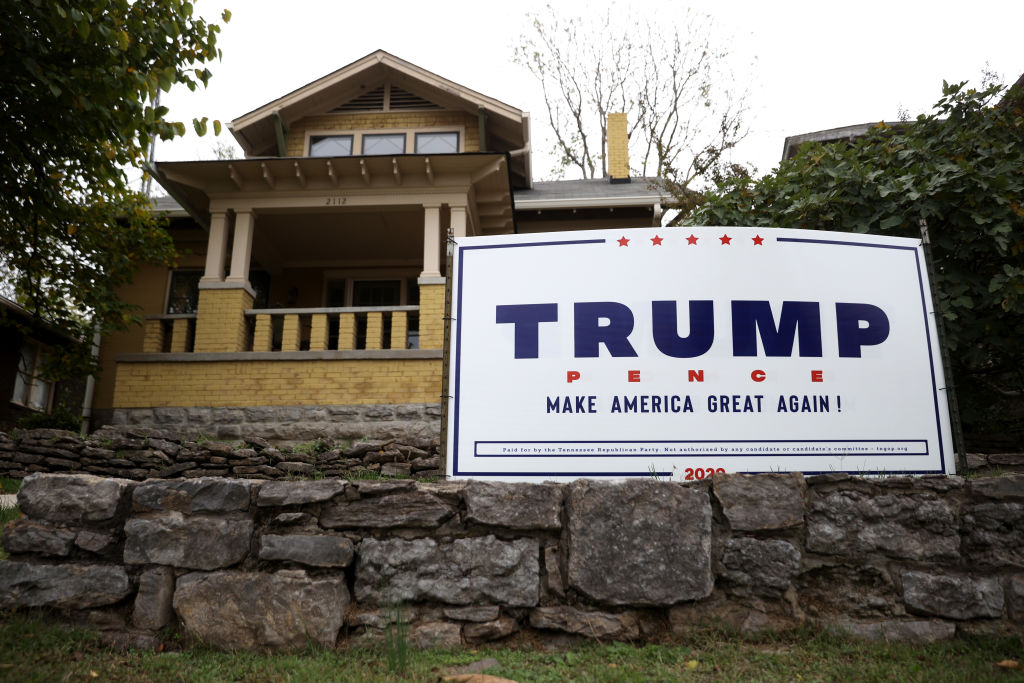Even before the U.S. economy was slammed by a pandemic, the typical American household’s income grew at a slower pace in more than half of the states under Donald Trump than in the years leading up to his presidency, according to a new Capital & Main analysis of U.S. Census data.
Those states include several key battlegrounds, undercutting one of Trump’s central campaign themes: that before COVID-19 his actions led to an economy he has described as “the best it has ever been.”
Pennsylvania saw its typical household’s income growth slow from 6.2% in Obama’s last three years to 4.7% in Trump’s first three years, while median household income growth in Wisconsin declined from 7.1% to 6%.
In New Hampshire typical household income growth slowed from 7.2% between 2013 and 2016 to 3.1% from 2016 to 2019, while in Iowa it slowed from 4.5% to 3%.
Nationally, median family income growth in Trump’s first three years was almost identical to the rate of growth in the three years prior to his presidency, according to one of the two main Census surveys. A second Census survey shows that median household income growth actually slowed in Trump’s first three years to 2.1% annually compared with 2.6% annually during Obama’s last three years.
In half of the battleground states identified by The Cook Political Report, real median household income growth slowed during Trump’s first three years.
Defenders of the president point to other indicators such as family income, which does not include households with single people and unrelated people living together. Family income, they point out, grew faster in Trump’s first three years than in the years before he took office.
Measured by typical household income, however, 26 states saw slower growth under Trump even before the pandemic — including in half of the 2020 battleground states identified by The Cook Political Report, a nonpartisan newsletter that analyzes elections. They include Georgia, North Carolina and Ohio, along with Iowa, New Hampshire, Pennsylvania and Wisconsin. In addition, two states with battleground districts, Maine and Nebraska, saw median household income growth slow in real terms.
In the hotly contested 2016 race between Trump and Hillary Clinton, sixteen of the 26 states where household income growth subsequently slowed supported Trump. Seven of those 16 are considered battlegrounds in the current presidential race.
The slowing income growth in most states during the Trump years came despite the fact that the president inherited a strong economy, unlike his predecessor, who took office during the worst downturn since the Great Depression.
“Obama was carrying us out of a very deep and long recession, and Trump inherited that. If anything, it’s notable that real income didn’t rise any faster under Trump than it did under Obama, despite the stimulus that his tax cuts were supposed to provide,” said Nari Rhee, director of the retirement security program at the University of California, Berkeley’s Center for Labor Research and Education.
The Capital & Main analysis of the latest American Community Survey data — conducted in conjunction with the UC Berkeley Labor Center — compares two periods of economic expansion: Obama’s last three years in office (2014 to 2016) to the first three years of the Trump presidency (2017 to 2019). In each case, the income reported in the prior years (2013 and 2016) allows us to measure growth over the subsequent years.
(In the map below, the “Obama expansion” is described as “2013-2016” and the “Trump expansion” is described as “2016-2019.”)
Trump has repeatedly promised that he can return the economy to its pre-pandemic heights. But the Capital & Main analysis shows even before the pandemic, the rate of income growth for the typical household was geographically uneven.
Stephen Moore, Trump’s former economic adviser and a senior fellow at the Heritage Foundation, has recently argued that Trump rescued an economy in serious financial trouble. “Family incomes surged to record-high levels in 2017, 2018 and 2019 as deregulation and tax cuts fueled a powerful engine,” Moore wrote in an editorial earlier this month.
Yet, for the first half of the Trump administration, during 2017 and 2018, real income growth for the typical household grew at less than half the rate it did in the two years before he took office, according to a previous analysis by Capital & Main and the Economic Policy Institute. All but two states experienced a trend of slower growth in median household income for the first two years of Trump’s presidency compared to the prior two years. The poorest households also saw slower income growth in Trump’s first two years compared with Obama’s last two years.
It was only in 2019 that the picture brightened for many Americans. The low unemployment rate and prolonged expansion likely led to rising incomes in 2019 as more people found jobs in a tight labor market, says David Cooper of the Economic Policy Institute.
“Despite all the rhetoric, companies continue to offshore jobs, the trade deficit with China continues to grow. Trump’s signature economic policy was a massive tax cut that overwhelmingly benefited the rich.”
~ David Cooper, Economic Policy Institute
However, Cooper gives little credit to Trump’s economic policy for the growth in household incomes in 2019, saying he “squandered every opportunity to lift up ordinary Americans.”
“The data are a good reminder that the Trump administration inherited one of the best economies in [a] generation. But they did nothing in their first three years that meaningfully altered the overall trajectory of the economy during that time,” he said. “Despite all the rhetoric, companies continue to offshore jobs, the trade deficit with China continues to grow. [Trump’s] signature economic policy was a massive tax cut that overwhelmingly benefited the rich.”
Cooper does not dispute the fact the family incomes did grow at a faster pace under Trump than under Obama, but he credits the fact that the country was eight years into an economic expansion, not Trump’s tax cuts or deregulatory agenda. The austerity measures pushed by a Republican-controlled Congress and state legislatures prevented family incomes from rising more under Obama, according to Cooper.
Of course, what’s foremost on people’s minds right now is a pandemic and a recession that has erased economic progress made under Obama and Trump alike.The employment gains made since the Great Recession have been wiped out by COVID-19-related job losses. Its impact on the typical household in battleground states and elsewhere will be more fully understood when the U.S. Census Bureau releases its income data next September, long after the election.
Copyright 2020 Capital & Main
Photo by Justin Sullivan/Getty Images





